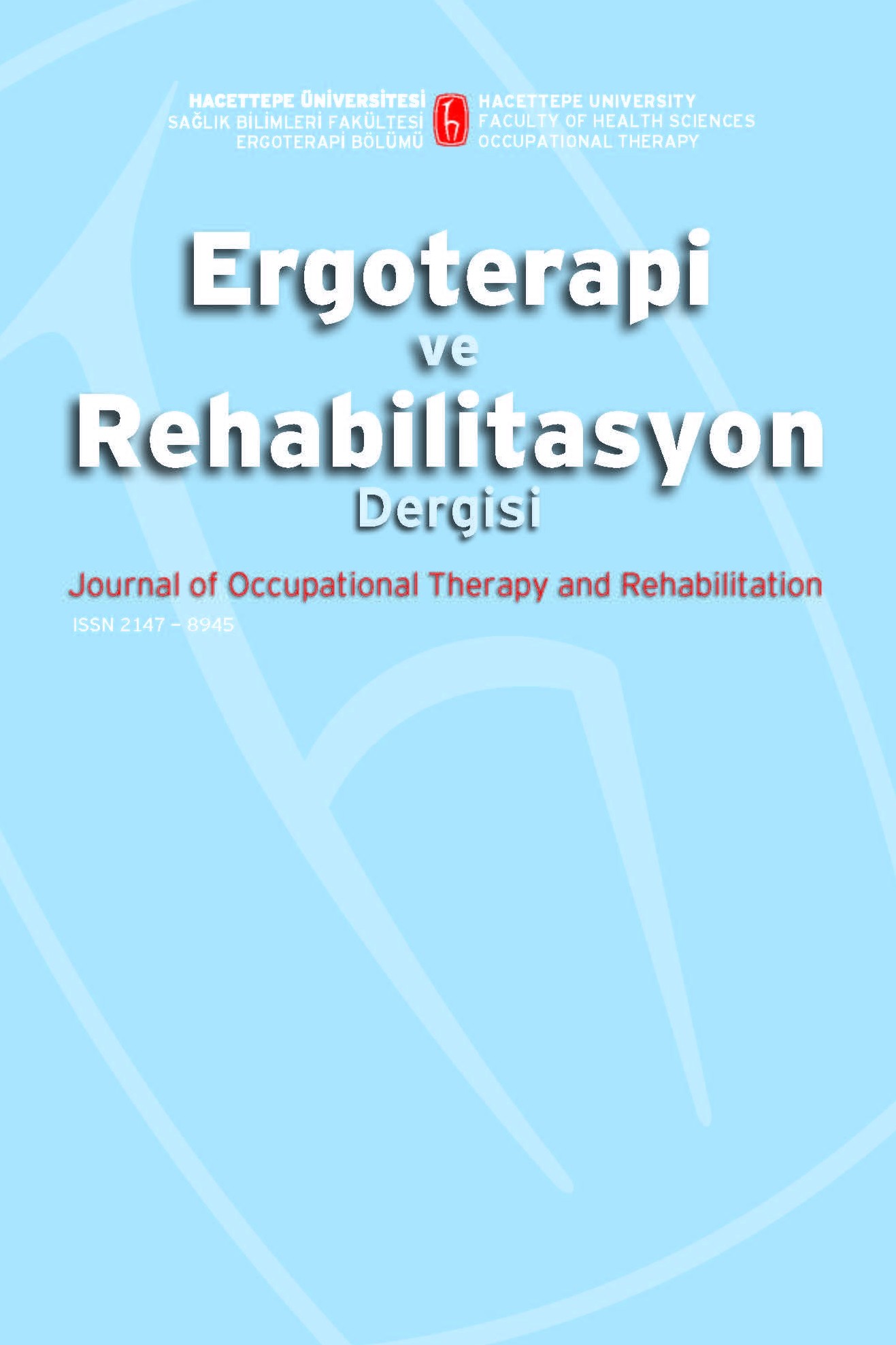Hemiparetik Serebral Palsi Tanılı Çocukların ve Bakım Verenlerinin Çocuklara Yönelik Aktivite Tercihlerinin İncelenmesi
An Investigation into Occupational Performance Preferences of Children with Hemiparetic Cerebral Palsy in Child’s and Caregivers’ Perspectives
___
- Akmeşe, P. P., Mutlu, A., & Günel, M. K. (2007). Serebral paralizili çocukların annelerinin kaygı düzeyinin araştırılması. Çocuk Sağlığı ve Hastalıkları Dergisi, 50, 236-240.
- Anttila, H., Autti-Rämö, I., Suoranta, J., Mäkelä, M., & Malmivaara, A. (2008). Effectiveness of physical therapy interventions for children with cerebral palsy: a systematic review. BMC Pediatrics, 8(1), 14.
- Beckung, E., & Hagberg, G. (2002). Neuroimpairments, activity limitations, and participation restrictions in children with cerebral palsy. Dev Med Child Neurol, 44(5), 309-316.
- Carswell, A., McColl, M. A., Baptiste, S., Law, M., Polatajko, H., & Pollock, N. (2004). The Canadian Occupational Performance Measure: a research and clinical literature review. Can J Occup Ther, 71(4), 210-222.
- Chong, W. F., & Ho, R. M. H. (2018). Caregiver needs and formal long-term care service utilization in the Andersen Model:an individual-participant systematic review and meta-analysis. International Journal of Integrated Care, 18(s1).
- Cup, E. H., Scholte op Reimer, W., Thijssen, M. C., & van Kuyk-Minis, M. (2003). Reliability and validity of the Canadian Occupational Performance Measure in stroke patients. Clin Rehabil, 17(4), 402-409.
- Galli, M., Cimolin, V., Rigoldi, C., Tenore, N., & Albertini, G. (2010). Gait patterns in hemiplegic children with cerebral palsy: comparison of right and left hemiplegia. Res Dev Disabil, 31(6), 1340-1345.
- Janse, B., Huijsman, R., Looman, W. M., & Fabbricotti, I. N. (2018). Formal and informal care for community-dwelling frail elderly people over time: a comparison of integrated and usual care in the Netherlands. Health Soc Care Community, 26(2).
- Law, M., Baptiste, S., Carswell, A., McColl, M. A., Polatajko, H., & Pollock, N. (2014). Canadian Occupational Performance Measure (COPM): CAOT publications.
- Law, M., Baptiste, S., McColl, M., Opzoomer, A., Polatajko, H., & Pollock, N. (1990). The Canadian Occupational Performance Measure: an outcome measure for occupational therapy. Can J Occup Ther, 57(2), 82-87.
- Law, M., Steinwender, S., & Leclair, L. (1998). Occupation, health and well-being. Can J Occup Ther, 65(2), 81-91.
- Mayston, M. (2002). Physiotherapy management in cerebral palsy:an update on treatment approaches. Clin Dev Med,(161), 147-160.
- Oskoui, M., Coutinho, F., Dykeman, J., Jetté, N., & Pringsheim, T. (2013). An update on the prevalence of cerebral palsy: A systematic review and meta-analysis. Dev Med Child Neurol, 55(6), 509-519.
- Özkan Tuncay, F., Fertelli, T. K., & Mollaoğlu, M. (2018). Effects of loneliness on illness perception in persons with a chronic disease. J Clin Nurs,27(7-8),e1494-e1500.
- Pan, A. W., Chung, L., & Hsin-Hwei, G. (2003). Reliability and validity of the Canadian Occupational Performance Measure for clients with psychiatric disorders in Taiwan. Occup Ther Int, 10(4), 269-277.
- Raina, P., O'Donnell, M., Rosenbaum, P., Brehaut, J., Walter, S. D., Russell, D., & et al. (2005). The health and wellbeing of caregivers of children with cerebral palsy. Pediatrics, 115(6), e626-e636.
- Rigby, P. J., Ryan, S. E., & Campbell, K. A. (2009). Effect of adaptive seating devices on the activity performance of children with cerebral palsy. Arch Phys Med Rehabil, 90(8), 1389-1395.
- Serdaroǧlu, A., Cansu, A., Özkan, S., & Tezcan, S. (2006). Prevalence of cerebral palsy in Turkish children between the ages of 2 and 16 years. Dev Med Child Neurol, 48(6), 413-416.
- Sköld, A., Josephsson, S., & Eliasson, A. C. (2004). Performing bimanual activities: the experiences of young persons with hemiplegic cerebral palsy. Am J Occup Ther, 58(4), 416- 425.
- Steenbergen, B., & Gordon, A. M. (2006). Activity limitation in hemiplegic cerebral palsy: evidence for disorders in motor planning. Dev Med Child Neurol, 48(9), 780-783.
- Torpil, B. (2017). Multipl Skleroz’lu bireylerde Kanada Aktivite Performans Ölçümü’nün Türkçe kültürel adaptasyonu, geçerlilik ve güvenilirliği (Yüksek Lisans Tezi). Hacettepe Üniversitesi Sağlık Bilimleri Enstitüsü, Ankara.
- ISSN: 2147-8945
- Yayın Aralığı: Yılda 3 Sayı
- Başlangıç: 2013
- Yayıncı: Hacettepe Üniversitesi Sağlık Bilimleri Fakültesi
Yaşlı Sürücülerin Araba Kullanma Becerilerinin Değerlendirilmesi
Orkun ARAN, Berkan TORPİL, Onur ALTUNTAŞ, Mert EŞME, Cafer BALCI, Burcu Balam YAVUZ, Mine UYANIK
Türkiye’deki Okul Öncesi Öğretmenlerin Tükenmişlik Düzeyleri
Ozcan DOĞAN, Zeynep Berna ERDİLLER YATMAZ
Orkun Tahir ARAN, Hülya KAYIHAN
Disleksili Çocuklarda Reaksiyon Hızı İle Motor Planlama Arasındaki İlişkinin İncelenmesi
Gonca BUMİN, Abdullah ŞAHİN, Gökçen AKYÜREK
İki Farklı Sağlık Mesleğinin Lisans Öğrencilerinin Özgecilik Düzeyinin İncelenmesi
Seramik Sektöründe Taşıma İşlemlerinde Ergonomik Risk Değerlendirmesi - Bir Pilot Çalışma
Seramik Sektöründe Taşıma İşlemlerinde Ergonomik Risk Değerlendirmesi: Bir Pilot Çalışma
Sağlık Bilimlerinin İki Farklı Bölümündeki Öğrencilerin Özgecilik Düzeyinin İncelenmesi
